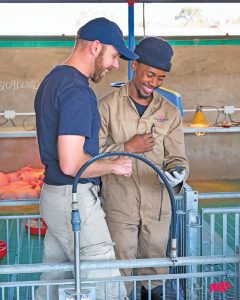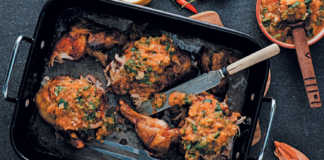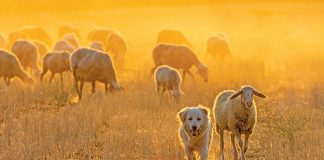
Photo: Lindi Botha
Having qualifications in industrial engineering has proved to be a distinct advantage to CP Kriek and his wife Gerda, owners of Taaibosch Piggery in Fochville, Gauteng. Given the key role of technology in agriculture today, theirs are amongst the skills that can take a farming operation to new heights.
While the Krieks both come from farming backgrounds, they approached Taaibosch Piggery as a new venture, and this has certainly been effective; they’ve been able to look at the business with fresh eyes, rather than simply accepting the way things have always been done.
When the Krieks purchased the farm in 2012, production proved a challenge, so it became vital to manage input costs and improve traceability.
READ Managing your pigs’ health
They also set about improving the genetics of their animals by introducing the genes of top-performing stud pigs from around the world. This enabled them to quickly increase their herd’s productivity.
Today, the farm markets a minimum of 1 000 baconers each week from its 2 300-sow breeding and nursery unit, weaning units, and growing and finishing unit. It also operates its own genetics unit of 300 purebred sows.
Kriek is convinced that none of this would have been possible without the use of state-of-the-art technology, which in this case is accessible to all his workers.
“To run an operation of this size successfully requires integrated systems, and Cloudfarms plays a significant role in that regard,” he explains.
Data collection and monitoring
The Cloudfarms pig-production-management software program provides real-time reporting through big data captured via workers’ smartphones as they move through the pig stalls. The data not only help to improve the day-to-day running of the piggery, but also provide strong forecasting models.
Everything from vaccinations to treatments is recorded on the app, and the records are accessible through each animal’s unique ID code.
“An animal’s complete history, from vaccinations and inseminations to injuries, weight gain or loss and temperament, can also be captured,” says Kriek.
READ Using chickens, pigs and sheep to save your soil
Data on semen collected from Taaibosch’s boars are also recorded. Each batch is analysed, classed, and marked with a QR code indicating the boar’s ID number and breed, the farm, date of production and batch number.

A corresponding sample of the semen is also kept in order to test its longevity. This is particularly important; if the semen doesn’t have longevity, it has a lower chance of eventually leading to a successful pregnancy.
Kriek notes that this body of information is helpful for understanding and solving issues that arise on the farm.
“If we get a poor litter, we can trace whether it was because something happened to the sow.
“An injury, infection, the insemination process – so many things can ultimately affect how a litter turns out, and we don’t want to cull the sow if the cause of the bad litter was something out of her control.
“The data also help us to prevent the issue from happening again,” he explains.
The process starts with the selection of a sow for artificial insemination (AI). This event is then created on Cloudfarms, and the QR code of the semen bag is scanned and logged to a particular sow.
The data captured at this point include the time of the AI and which worker conducted it.
“In the long run, all the variables can be compared to determine the ideal situation for the best conception and weaning rates, thereby contributing to improved production,” says Kriek.
One fact has become abundantly clear through analysing the data: when workers are calm and focused, and operate in a calm and focused environment, the results are a higher conception rate and healthier litters.
“Sows pick up on cues from their environment. We therefore try to do the inseminations later in the morning when it’s still cool, but after the workers have completed their most pressing tasks, because then they aren’t rushed and irritated.”
Every detail of the cycle is captured on Cloudfarms. Pregnancy tests are performed at 28 to 35 days and if a sow has failed to conceive, the data on her insemination can be traced to find a possible cause, and the process started again.
After insemination, data collection continues throughout gestation. This includes feeding, body condition scoring, vaccinations, and any other observations.
Accurate traceability
According to Kriek, one of the greatest benefits of the Cloudfarm technology is the accurate traceability it provides, especially when it comes to the use of medication.
“If any medication has a withdrawal period, the animals who were medicated won’t be sent to slaughter before this period has ended. And, based on the animals’ existing medication records, the active ingredients in medications can also be varied to prevent the development of resistance.
“Cloudfarms also assists with keeping an inventory of medicines, as every injection is logged against an individual animal’s records, thereby reducing the inventory by that specific dose,” he says.
READ How intensive sheep farmers can improve traceability and profit
This means that when a pig is slaughtered, all information on the animal is available, including the time and dose of all injections, group feed intake, weight gain, time from wean to slaughter, and the details of the parent boar and sow.
This is a major help with timely decision-making at the piggery, and Kriek is equally excited about its future modelling possibilities. These could include a scenario where the ideal boar is matched with the ideal sow, in the ideal climate and at the ideal time of day, to produce the optimal litter and thus the optimal pig at the best possible price.
Adapted for Africa
A downside of the technology is that it comes at a steep price. Another is that since data are captured in real time, a reliable Internet connection is essential. The Krieks, for example, had to invest in wireless connectivity.
Currently, theirs is the only farm in South Africa using Cloudfarms technology, but Kriek thinks this could change by the end of the year; he and Gerda are collaborating with the program’s developers in Eastern Europe to make the system more accessible to the African market.
“Few small-scale farmers in South Africa have the means to invest in this technology, but having it as a smartphone app will make it far more affordable and user-friendly.
“Because Cloudfarms was developed as a mobile-friendly program from the start, using it on a smartphone is easy and efficient. In this way, we can start providing solutions that fit African conditions and budgets so that all farmers can benefit from the technology, no matter how small their operations.”
While his farm relies on genetics from Genesus in Canada to increase productivity, Kriek believes that since African conditions differ so widely from those elsewhere in the world, localised genetics are required.
In partnership with Genesus, Taaibosch has a breeding unit consisting of Large White, Landrace and Duroc pigs, and this stud provides animals for their own farm and others. In 2017, the Krieks decided to breed their own genetics, which would give them better control over their value chain and input costs, and enable them to breed pigs better suited to local conditions.
“The climates in which Europeans and Canadians farm are very different to those in Africa, as are the management systems. So while they can manage a litter of 18 piglets, not all farmers here can. Buying genetics that provide such big litters is counter-productive if all the piglets aren’t going to make it.
“What’s more important is that the genetics provide strong, robust piglets that will make it beyond weaning,” explains Kriek.
With pork caught up in a perpetual competition with chicken for consumers’ food budgets, he believes that the only way out is to increase the value proposition of pork.
“I want to build on genetics that produce not only good carcasses, but good eating quality.This means more marbling that will ensure more tender meat with a better flavour.
“We can only take part in the price war up to a point. After that, we need to differentiate ourselves on the market and get consumers to a point where they prefer to buy pork rather than chicken. Pork should be a sought-after product, not an alternative to beef and chicken.”
Control over inputs
Taaibosch also runs its own feed mill to ensure optimal nutrition for all the production stages across the different units. Having control over this input also helps to bring down costs and aids quality control and production.
Kriek has implemented Nedap technology for his feeding system, which collects data on feeding and weight gain thousands of times every day.
Each pig is fitted with a radio-frequency identification tag that logs its feed intake and weight gain whenever feed is dispensed. The system recognises an individual sow entering the Nedap system and dispenses a specific ration for her.
After feeding, the sow is weighed, and this data is uploaded to the Nedap and Cloudfarms systems. Records of every sow are kept, and their ideal weights are maintained with rations adjusted week by week.
READ Optimising feed efficiency to boost profits
Kriek says a major benefit of this technology is that individual feeding and weight gain can be controlled in a group setting. It also gives him access to the vast global dataset for feeding practices, which means he can compare his herd to global averages and trends.
“Our feed curves differ hugely from those in Europe, which is why we need African data and solutions.”
Finding custom-made solutions for Taaibosch is an ongoing journey for the couple. Asked how they maintain their continuous innovation, Kriek says: “We’re always thinking about how to improve the business as a whole, and not just one aspect at a time.
“Thanks to our engineering backgrounds, we always have our thinking caps on! We strive for excellence, and always want to be better than we were yesterday.”
Email [email protected].











